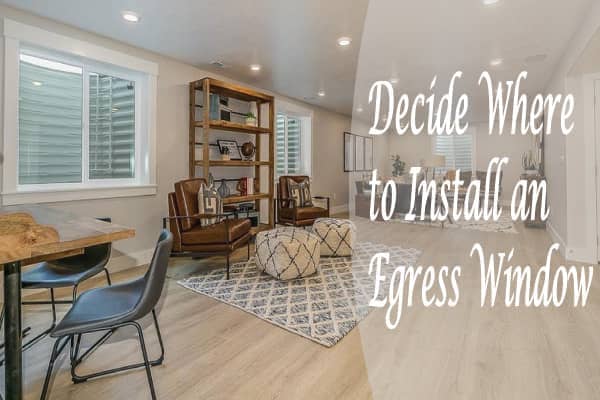You are going to install an egress window. You know you need it to comply with building codes and you also feel a personal responsibility for adding a crucial safety feature to a basement where people will be spending time. Decision complete, right? Well not quite. Now you need to figure out where to put the egress window. The wall at the bottom of the stairs? What about near the corner where the couch will go? There is a lot to consider.
To help you answer this question, we’ve put together some of our top factors to keep in mind when deciding on a location for your egress window.
Consider the Egress Code
First and foremost, you need to consider the egress code in the region where you are located. Most egress codes in the USA require an egress window to be in any sleeping room in a basement. This would mean if you had two bedrooms, you would need two separate egress windows. Often, non-bedroom basement spaces requiring egress windows (such as a workspace or fitness room), do not require the window to be in the room itself if it is on the same floor. For example, a bedroom and office in the basement could be served with a single egress window in the bedroom.
Exact codes can vary drastically from jurisdiction to jurisdiction. It is crucially important that you do your research first to determine what requirements will exist in your region. If your local building code is stricter and requires the egress window to be in specific rooms, your options for where to put an egress window are a bit more limited, but not eliminated.
Sunlight can help determine where to put an egress window
Sunlight is a huge factor to consider. One of the major draws of an egress window is that they can bring in natural light and brighten up an otherwise dark and dreary space.
The sun follows a slightly southern east-to-west arc across the sky. This means that East facing windows tend to get strong morning sunlight while west facing windows get strong afternoon and evening sun and south facing windows tend to get moderate sunlight the entire day. Of course, this is not the same for every house. Trees, neighboring houses, or other landscape features can block sunlight from getting in depending on their specific locations relative to the proposed location of the window.
When it relates to sunlight, you will also want to keep the intended purpose of the room in mind. Is your semi-nocturnal teenager moving their bedroom down there? Perhaps an east facing window bringing in the morning sun might be a step towards getting them out of bed before noon. Are you setting up an office? Depending on the layout, you may want to avoid a west facing window that will put a glare on your computer screen all afternoon. Every sunlight situation is different and really there is no right or wrong answer when it comes to where to put an egress window, it all comes down to personal preference.
Available outdoor space can help determine where to put an egress window
A significant portion of egress windows will require a window well to meet code and be operational. While this is a perfectly normal part of an egress window installation project, you will need to be mindful of the amount of space the well requires. Often minimum dimensions will be dictated by building codes, but some people enjoy the look of a bigger, more open feeling window well.
Where the size of a well can become an issue is if you have narrow pathways, which is particularly common along the sides of a house. Suppose you have a six-foot wide gap between your house and the side fence, installing an egress window well that must have a three-foot projection all but eliminates this pathway. Again, this may not be a concern for everyone, but is another factor to keep in mind when deciding where to install an egress window.
The Current windows in your home can help determine where to put an egress window
Installing an egress window in an existing hole is far and away the easiest option. Most likely, you will need to enlarge the hole of an existing window to fit an egress window. If this is the case, you will save a lot of hassle by expanding the existing opening vertically rather than widening it horizontally. By expanding it vertically, you will not need to worry about compromising the structural integrity of the wall when cutting the foundation. Finding an egress window that is the same width as one of your existing windows and cutting the height to match is a great option. This means that when deciding where to put an egress window, you should take a look at where the existing basement windows are located.
The layout of your basement can help determine where to put an egress window
If you do need to cut a fresh opening in the foundation or widen an opening horizontally, you should consider the direction of the floor joists that are supporting the floor above. If the joists run perpendicular to the wall you are considering cutting, this is a load bearing wall, and you will need to add additional structural support.
Conclusion
There are a handful of considerations to keep in mind when deciding where to put an egress window. Every situation is unique and, as long as the egress code requirements are met, ultimately come down to personal preference. If you are at this stage in your renovation project, take a look around and have a quick think over all the points mentioned above. You will know which ones apply to you and which ones you believe are important to your situation. Use our certified Egress Window Installation Experts
Call BAM for all your egress window needs, from start to finish, our specialists are up to date with codes and can help determine what egress window will fit your home’s needs.
Here at Bam Basements and Masons of Des Moines, we offer only the best egress windows on the market. We installed 126 egress windows in 2021 alone. Our warrantied, award-winning egress basement window products are just what you need to create a more beautiful, comfortable, and valuable space in your home.


